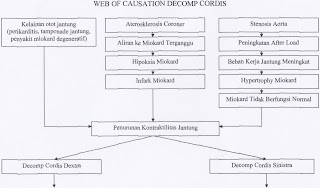I. DEFINISI
ARDS atau Sindroma Distres Pernafasan Dewasa ( SDPD ) adalah kondisi kedaruratan paru yang tiba-tiba dan bentuk kegagalan nafas berat, biasanya terjadi pada orang yang sebelumnya sehat yang telah terpajan pada berbagai penyebab pulmonal atau non-pulmonal ( Hudak, 1997 ).
II. ETIOLOGI
Menurut Hudak & Gallo ( 1997 ), gangguan yang dapat mencetuskan terjadinya ARDS adalah ;
Sistemik :
· Syok karena beberapa penyebab
· Sepsis gram negative
· Hipotermia
· Hipertermia
· Takar lajak obat ( Narkotik, Salisilat, Trisiklik, Paraquat, Metadone, Bleomisin )
· Gangguan hematology ( DIC, Transfusi massif, Bypass kardiopulmonal )
· Eklampsia
· Luka bakar
Pulmonal :
· Pneumonia ( Viral, bakteri, jamur, penumosistik karinii )
· Trauma ( emboli lemak, kontusio paru )
· Aspirasi ( cairan gaster, tenggelam, cairan hidrokarbon )
· Pneumositis
Non-Pulmonal :
· Cedera kepala
· Peningkatan TIK
· Pascakardioversi
· Pankreatitis
· Uremia
III. PATHOFISIOLOGI
Secara pathofisiologi terjadinya ARDS dapat dijelaskan sebagai berikut :
Kerusakan sistemik
↓
Pe ↓ perfusi jaringan
↓
Hipoksia seluler
↓
Pelepasan faktor-faktor biokimia
( enzim lisosom, vasoaktif, system komplemen, asam metabolic, kolagen, histamine )
↓
Pe ↑ permiabilitas kapiler paru
↓
Pe ↓ aktivitas surfaktan
↓
Edema interstisial alveolar paru
↓
Kolaps alveolar yang progresif
↓
Pe ↓ compliance paru
Stiff lung
Pe ↑ shunting
↓
Hipoksia arterial
Keterangan ;
Pergerakan cairan paru pada kasus ARDS :
· Terjadi peregangan / deposisi dari mebran hialin
· Intraalveolar Epithelial junction melebar
· Terjadi edema interstisial, cairan intravascular keluar, protein keluar masuk ke dalam alveoli
· Endotel kapiler paru pecah
· Eritrosit keluar dari intavaskuler masuk kedalam paru menyebabkan fenomena frozzy sputum
IV. KOMPLIKASI
Menurut Hudak & Gallo ( 1997 ), komplikasi yang dapat terjadi pada ARDS adalah :
· Abnormalitas obstruktif terbatas ( keterbatasan aliran udara )
· Defek difusi sedang
· Hipoksemia selama latihan
· Toksisitas oksigen
· Sepsis
V. MANIFESTASI KLINIK
Gejala klinis utama pada kasus ARDS adalah :
· Penurunan kesadaran mental
· Takikardi, takipnea
· Dispnea dengan kesulitan bernafas
· Terdapat retraksi interkosta
· Sianosis
· Hipoksemia
· Auskultasi paru : ronkhi basah, krekels, stridor, wheezing
· Auskultasi jantung : BJ normal tanpa murmur atau gallop
VI. PEMERIKSAAN PENUNJANG
Pemeriksaan hasil Analisa Gas Darah :
· Hipoksemia ( pe ↓ PaO2 )
· Hipokapnia ( pe ↓ PCO2 ) pada tahap awal karena hiperventilasi
· Hiperkapnia ( pe ↑ PCO2 ) menunjukkan gagal ventilasi
· Alkalosis respiratori ( pH > 7,45 ) pada tahap dini
· Asidosis respiratori / metabolik terjadi pada tahap lanjut
Pemeriksaan Rontgent Dada :
· Tahap awal ; sedikit normal, infiltrasi pada perihilir paru
· Tahap lanjut ; Interstisial bilateral difus pada paru, infiltrate di alveoli
Tes Fungsi paru :
· Pe ↓ komplain paru dan volume paru
· Pirau kanan-kiri meningkat
VII. PENATALAKSANAAN MEDIS
· Pasang jalan nafas yang adekuat * Pencegahan infeksi
· Ventilasi Mekanik * Dukungan nutrisi
· TEAP * Monitor system terhadap respon
· Pemantauan oksigenasi arteri * Perawatan kondisi dasar
· Cairan
· Farmakologi ( O2, Diuretik, A.B )
· Pemeliharaan jalan nafas
VIII. PRIORITAS MASALAH KEPERAWATAN
Prioritas masalah keperawatan pada klien dengan ARDS menurut Doenges (2001) adalah sebagai berikut :
- Tidak efektifnya bersihan jalan nafas
- Gangguan pertukaran gas
- Resiko tinggi terjadi kekurangan volume cairan
- Cemas




